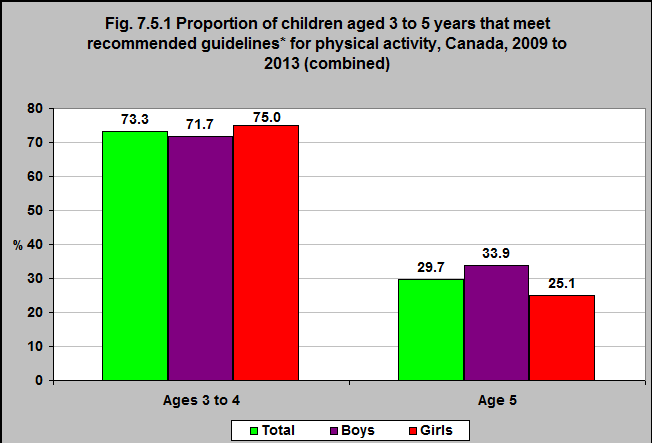Proportion of children aged 3 to 5 years that meet recommended guidelines for physical activity, Canada, 2009 to 2013 (combined)

Notes:
Age 5 girls use with caution.
*According to the Canadian Physical Activity Guidelines for the Early Years (0 – 4 years): Infants (aged less than 1 year) should be physically active several times daily – particularly through interactive floor-based play; Toddlers (aged 1–2 years) and preschoolers (aged 3–4 years) should accumulate at least 180 minutes of physical activity at any intensity spread throughout the day; Children are to progress toward at least 60 minutes of energetic play by age 5. http://www.csep.ca/CMFiles/Guidelines/CSEP_PAGuidelines_early-years_en.pdf – accessed June 18, 2017.
Source: CICH graphic created using data adapted from Statistics Canada. Health Reports. Physical activity and sedentary behaviour of Canadian children aged 3 to 5. Research article, Catalogue no. 82-003-X, Vol. 27, no. 9, pp. 14-23, September 2016. http://www.statcan.gc.ca/pub/82-003-x/2016009/article/14653-eng.htm -accessed June 22, 2017.
Between 2009 and 2013, 73% of children 3 to 4 years met the recommended guidelines of 180 minutes of physical activity every day. Among children 5 years of age, the recommendation of at least 60 minutes of moderate-to-vigorous physical activity every day was met by 30%. No significant difference was observed between boys and girls.
On average, children aged 3 to 4 years were sedentary 436 minutes a day (7 hours and 16 minutes), which was equivalent to 60.7% of their wear time. Children 5 years of age were sedentary 7 hours and 38 minutes per day on average.1
Compared with 5 year-olds, children aged 3 to 4 were more likely to meet the physical activity guidelines. However, the guidelines for children 3 to 4 years of age recommend a larger volume of less intense activities.1
1Statistics Canada. Health Reports. Physical activity and sedentary behaviour of Canadian children aged 3 to 5. Research article, Catalogue no. 82-003-X, Vol. 27, no. 9, pp. 14-23, September 2016. http://www.statcan.gc.ca/pub/82-003-x/2016009/article/14653-eng.htm-accessed March 22, 2017.
Implications
While it is encouraging that about three-quarters of 3 and 4 year olds meet the recommended guidelines for physical activity, it is quite worrisome that only about 3 in 10 of 5 year olds do so.
There are many benefits associated with physical activity in young children. It helps them develop motor skills, improves their bone and skeletal health, helps them achieve a healthy body weight, decreases cardio-metabolic disease risk factors, and improves their psychosocial health and cognitive development.2 On the other hand, excess time spent in sedentary behaviour has been associated with lower measures of psychosocial health and cognitive development, and negative impacts on healthy body weight.3
2Timmons BW, Leblanc AG, Carson V, et al. Systematic review of physical activity and health indicators in the early years (age 0-4 years). Applied Physiology and Metabolism 2012; 37: 773-92.
3Leblanc AG, Spence JC, Carson V, et al. Systematic review of sedentary behaviour and health indicators in the early years (age 0-4 years). Applied Physiology and Metabolism 2012; 37: 753-72.
